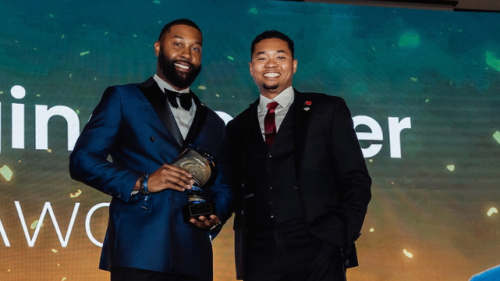If you’re wondering how to become a UX designer after years working in another field, Kent State University alum Brian Parsons, MS ’18, has one piece of advice: “Take on any roles you can with a UX-related title in them, even if it’s volunteering.”
A former business systems analyst who was unhappy with his career, Brian realized that the most fulfilling aspects of his job related directly to the UX field. Read how choosing Kent State’s online Master of Science in User Experience Design helped him make a career transition from business systems analyst to UX researcher at powerhouse Sony PlayStation.
1. What Made You Decide to Pursue a Career in Ux Design?
After graduating college, I fell into a business systems analyst role documenting requirements, working with stakeholders to figure out their goals and being an IT liaison for large projects for about six years. I was unhappy with most of the work.
After a rough project with a client, I stepped back and took inventory of the few things I liked doing, such as mocking up prototypes, interviewing users and problem-solving. With a little bit of research, I found out that everything I like about my job fit into a field called “UX.” On top of that, UX encompassed even more aspects that I knew I would enjoy, such as information architecture, psychology and interaction design. I fell in love with the UX field instantaneously.
2. Why Did You Choose Kent State’s Online Master of Science in User Experience Design?
Starting a new family, it wasn’t realistic for me to start my career over and take a UX internship or entry-level job, simply because the pay couldn’t support my family. I applied for Kent State’s online Master’s in UX Design program because it is designed for working professionals and has the best-priced tuition from an accredited university I had heard of. (My father grew up in Kent, Ohio.) That meant I could work and make a career transition into a UX role with real credentials.
3. How Did You Enter the Ux Field? What Types of Jobs Did You Start Out With?
I took a contract role for Nike’s e-commerce website as a Business Systems Analyst knowing that it would be a great jumping off point to a UX role. My plan worked out. A close friend of mine from high school knew I was in the KSU program and his company, Focus Brands---Cinnabon, Auntie Anne’s, Moe’s Southwest Grill, McAllister’s, Schlotzsky’s and Carvel---called me to be the UX designer for six new websites they were planning on building.
4. How Was the Career Transition From Business Systems Analyst to Ux? Do You Have Any Advice for Someone Wondering How to Become a Ux Designer?
It’s funny how at the time I knew my skills as a business systems analyst (BSA) would easily carry over to UX, especially UX strategy, but hiring managers didn’t know what a BSA did. The job search was extremely difficult because my resume had nothing with UX related job titles, and the computer systems reading my resumes immediately threw me out. I applied to 170 jobs in the span of two months after Nike and only received three in-person interviews.
Talking to hiring managers was a lot easier because I knew I had the skill set along with what I was learning in the KSU program. If there is one piece of advice I would give, it’s to take on any roles you can with a UX-related title in them, even if it’s volunteering for a local school-board campaign, which I did. This adds credentials to your resume and builds up your portfolio.
5. What Sorts of Projects, Tasks, or Research Do You Typically Work on at Your Job?
I’m very lucky that I get to work on a wide range of projects at Sony PlayStation. My group focuses on the PlayStation console, so literally anything you can do on the console, we are responsible for researching it. That includes voice chats, accessibility, search and e-commerce, just to name a few.
6. Was There Anything in Particular From Your Portfolio That You Feel Helped You Land This Job?
Two things: My work (research and design) on the Moe’s Nutrition Calculator, and bringing accessibility into the forefront at Focus Brands. The nutrition calculator was a classic project piece, but the accessibility work showed how I used my passion and influence to drive our team to better products.
7. Has There Been Anything From Your Coursework That You’ve Been Able to Immediately Apply to Your Work?
Literally everything. I can’t recommend enough taking a part-time program while working in that particular field because you get to apply what you learned from the night before to work the next morning. It’s reinforcing your learning and builds skills two times faster. As far as courses, user research and content strategy were the two most helpful topics for my role at the time because no one at Focus Brands knew what they were, and we desperately needed them.
The hardest part was convincing management that we needed them, but luckily KSU had us read “Selling Usability” as one of our first books, which helped me influence the right people. That book never left my desk.
8. Why Did You Pursue Your Master’s, Rather Than Earn a Certificate in Ux Design?
I had previously attended a non-degree UX course in San Francisco. Although it was interesting, I quit after six weeks because it wasn’t engaging enough and I felt like the instructor was mediocre at best. My wife and I had a lot of discussions about this, and in the end the cost of that full-time three-month program would have come out to the same cost as KSU’s master’s program due to lack of income for three months and the high price of rent in San Francisco.
With the cost being equal, it seemed obvious to go with the program that would give me a respected diploma. It separates me drastically from boot camp graduates. KSU provided multiple great instructors who are currently working in the UX field and always available for additional help, career advice and feedback on your current professional projects outside of school. That alone was the most valuable part of the program, especially while making my career transition into the UX field.
It’s Never Too Late to Shift Careers
A master’s degree can equip you with the hard skills, industry knowledge and network of professionals you need to break into UX. Learn more about the highly relevant courses offered as part of Kent State’s online Master’s in UX Design, and explore our intuitive online experience.





